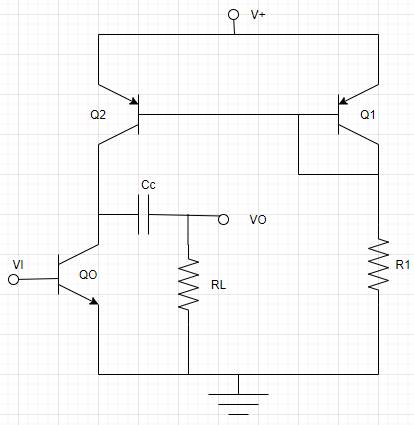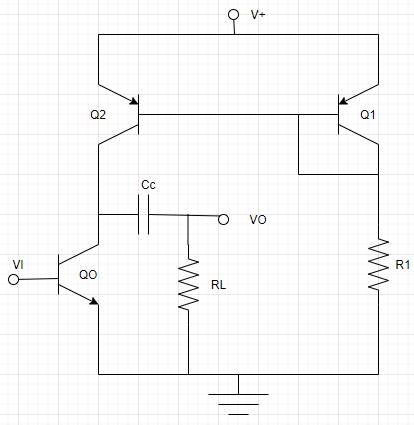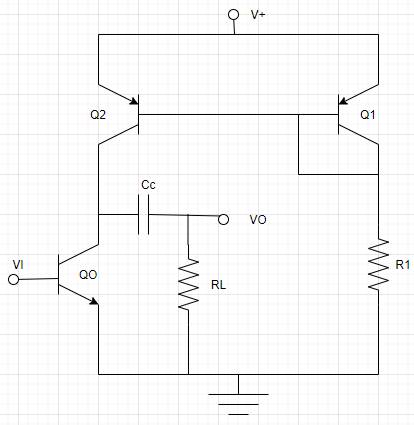
Concept explainers
(a)
The small-signal voltage gain for given RL .
(a)
Answer to Problem 10.81P
Av=−1978
Explanation of Solution
Given:
R1=47kΩVAN=120VVAP=90VV+=3VVEB(on)=0.6V
Calculation:
The given circuit is,

The transistor Q1 and Q2 are matched so expression for reference current will be,
IREF=V+−VEB(on)R1
IREF=3−0.647×103IREF=2.447×103IREF=51.06μA
Now calculate the small-signal voltage gain,
Av=−(IREFVT)(IREFVAN+1RL+IREFVAP)
Substitute the given values,
Av=−(51.06×10−60.026)(51.06×10−6120+1RL+51.06×10−690)Av=−(1.964×10−3)(4.255×10−7+1RL+5.673×10−7)Av=−(1.964×10−3)(9.928×10−7+1RL) (1)
Substitute RL=∞ in equation (1)
Av=−(1.964×10−3)(9.928×10−7+1∞)Av=−(1.964×10−3)(9.928×10−7+0)Av=−(1.964×10−3)(9.928×10−7)
Av=−1978
Conclusion:
Av=−1978
(b)
The small-signal voltage gain for given RL .
(b)
Answer to Problem 10.81P
Av=−454
Explanation of Solution
Given:
R1=47kΩVAN=120VVAP=90VV+=3VVEB(on)=0.6V
Calculation:
The given circuit is,

The transistor Q1 and Q2 are matched so expression for reference current will be,
IREF=V+−VEB(on)R1
IREF=3−0.647×103IREF=2.447×103IREF=51.06μA
Now calculate the small-signal voltage gain,
Av=−(IREFVT)(IREFVAN+1RL+IREFVAP)
Substitute the given values,
Av=−(51.06×10−60.026)(51.06×10−6120+1RL+51.06×10−690)Av=−(1.964×10−3)(4.255×10−7+1RL+5.673×10−7)Av=−(1.964×10−3)(9.928×10−7+1RL) (1)
Substitute RL=300kΩ in equation (1)
Av=−(1.964×10−3)(9.928×10−7+1300×103)Av=−(1.964×10−3)(9.928×10−7+3.33×10−6)Av=−(1.964×10−3)(4.326×10−6)
Av=−454
Conclusion:
Av=−454
(c)
The small-signal voltage gain for given RL .
(c)
Answer to Problem 10.81P
Av=−256
Explanation of Solution
Given:
R1=47kΩVAN=120VVAP=90VV+=3VVEB(on)=0.6V
Calculation:
The given circuit is,

The transistor Q1 and Q2 are matched so expression for reference current will be,
IREF=V+−VEB(on)R1
IREF=3−0.647×103IREF=2.447×103IREF=51.06μA
Now calculate the small-signal voltage gain,
Av=−(IREFVT)(IREFVAN+1RL+IREFVAP)
Substitute the given values,
Av=−(51.06×10−60.026)(51.06×10−6120+1RL+51.06×10−690)Av=−(1.964×10−3)(4.255×10−7+1RL+5.673×10−7)Av=−(1.964×10−3)(9.928×10−7+1RL) (1)
Substitute RL=150kΩ in equation (1)
Av=−(1.964×10−3)(9.928×10−7+1150×103)Av=−(1.964×10−3)(9.928×10−7+6.66×10−6)Av=−(1.964×10−3)(7.659×10−6)
Av=−256
Conclusion:
Av=−256
Want to see more full solutions like this?
Chapter 10 Solutions
Microelectronics: Circuit Analysis and Design
- 1. You are to design a 9-volt battery operated baseband PAM communication system that must last great than 10 years without replacing the batteries. The application requires a BER of <10^-4 and a data rate of 200bps. The channel can be modeled as AWGN with a noise power spectral density of 10^-9 W/Hz and a channel loss of 10 dB. (a) Estimate the required capacity of the batteries. (The battery life (hours) is equal to the battery volts times of the battery capacity (Amps* hours) divided by the total load (Watts)) and (b) Can you easily find this battery? If not, what would you suggest be done?arrow_forward3. You are on a design team tasked to design a system of remote sensors that use PAM. Here is what the team knows/assumptions: The remote sensor will use a single AA battery required to power the sensors. The system has a bandwidth of 2KHz and requires a data rate of 12 Kbps and a BER of less than 1*10^-4. The typical channel has maximum losses of 35 dB and a noise power spectral density is 10^-9 W/Hz. Your boss assigns you with the task of estimating how long the battery will last.arrow_forward2. The noise power (in watts) measured in a baseband PAM communication channel is 230*10^-6 Watts. The transmitter output power is 600 mW and has a data rate of 300 Kbps. The channel bandwidth is 100 KHz with losses that can be modeled as 0.5dB/meter. The application requires a BER ofarrow_forward
- Q21arrow_forwardI need help with this problem and an step by step explanation of the solution from the image described below. (Introduction to Signals and Systems)arrow_forwardI need help with this problem and an step by step explanation of the solution from the image described below. (Introduction to Signals and Systems)arrow_forward
- I need help with this problem and an step by step explanation of the solution from the image described below. (Introduction to Signals and Systems)arrow_forwardI need help with this problem and an step by step explanation of the solution from the image described below. (Introduction to Signals and Systems)arrow_forwardI need help with this problem and an step by step explanation of the solution from the image described below. (Introduction to Signals and Systems)arrow_forward
 Introductory Circuit Analysis (13th Edition)Electrical EngineeringISBN:9780133923605Author:Robert L. BoylestadPublisher:PEARSON
Introductory Circuit Analysis (13th Edition)Electrical EngineeringISBN:9780133923605Author:Robert L. BoylestadPublisher:PEARSON Delmar's Standard Textbook Of ElectricityElectrical EngineeringISBN:9781337900348Author:Stephen L. HermanPublisher:Cengage Learning
Delmar's Standard Textbook Of ElectricityElectrical EngineeringISBN:9781337900348Author:Stephen L. HermanPublisher:Cengage Learning Programmable Logic ControllersElectrical EngineeringISBN:9780073373843Author:Frank D. PetruzellaPublisher:McGraw-Hill Education
Programmable Logic ControllersElectrical EngineeringISBN:9780073373843Author:Frank D. PetruzellaPublisher:McGraw-Hill Education Fundamentals of Electric CircuitsElectrical EngineeringISBN:9780078028229Author:Charles K Alexander, Matthew SadikuPublisher:McGraw-Hill Education
Fundamentals of Electric CircuitsElectrical EngineeringISBN:9780078028229Author:Charles K Alexander, Matthew SadikuPublisher:McGraw-Hill Education Electric Circuits. (11th Edition)Electrical EngineeringISBN:9780134746968Author:James W. Nilsson, Susan RiedelPublisher:PEARSON
Electric Circuits. (11th Edition)Electrical EngineeringISBN:9780134746968Author:James W. Nilsson, Susan RiedelPublisher:PEARSON Engineering ElectromagneticsElectrical EngineeringISBN:9780078028151Author:Hayt, William H. (william Hart), Jr, BUCK, John A.Publisher:Mcgraw-hill Education,
Engineering ElectromagneticsElectrical EngineeringISBN:9780078028151Author:Hayt, William H. (william Hart), Jr, BUCK, John A.Publisher:Mcgraw-hill Education,





